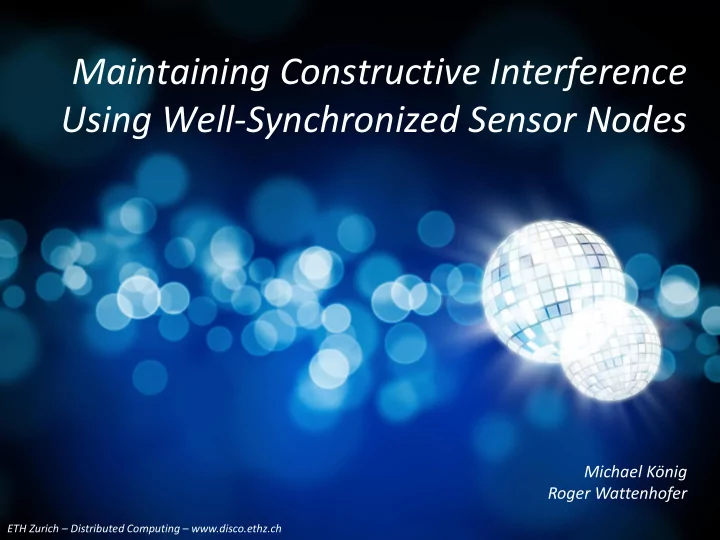

Maintaining Constructive Interference Using Well-Synchronized Sensor Nodes Michael König Roger Wattenhofer ETH Zurich – Distributed Computing – www.disco.ethz.ch
Constructive Interference (CI) + = + =
Traditional Approaches to Transmission Synchronization • Use an external clock. • Don’t send complicated data. – SlotOS [Flury et al., 2010] – Black Burst Synchronization [Gotzhein et al., 2011] • Use triggering packets. – Glossy [Ferrari et al., 2011]
CI for Broadcasting: Glossy
Traditional Approaches to Transmission Synchronization • Use an external clock. • Don’t send complicated data. • Use triggering packets. Can we do it … • … without an external clock, • … with normal data packets, • … and without triggering packets?
Our Work • General case CI • TelosB • Minimizing error sources: = – Clock synchronization S A S B – Transmission timing S – Travel time S B S A R
CI Timing Requirements (IEEE 802.15.4) • 250,000 bit/s • 4-bit symbols • 32 chips/symbol, on I and Q phases in parallel 1 µs per chip 1 chip error
Error Sources = • Clock synchronization e clock = clock A – clock B S S • Transmission Timing e transmit = delay B – delay A S • Travel Time e travel = traveltime B – traveltime A S S R • Total Error e total = e clock + e transmit + e travel • Goal |e total | << 0.5 µs
Travel Time (e travel ) S A R S B • 30 meters = 0.1 µs travel time • Workaround: negligible for senders of similar distance – |e travel | < 0.033 µs • Recent work – “Time -of-Flight Aware Time Synchronization” (TATS) [Lim et al., 2016]
= Clock Synchronization (e clock ) S A S B • MAC layer timestamping • Averaging out errors • Drift compensation • Combining clocks • Extended precision timestamps
Drift Compensation
Combining Clocks 2 clocks: • 32 kHz quartz • 4 MHz DCO (digitally controlled oscillator)
Combined Timestamp Virtual High-Resolution Time [Schmid et al., 2010]
Clock Synchronization Result • |e clock | < 0.05 µs in 20% of cases • |e clock | < 0.25 µs in 75% of cases
Transmission Timing (e transmit ) S • Measure: TXON command SFD pin (“start of frame delimiter”) (DCO ticks)
Naïve Transmission Timing if (TargetTime - GetGlobalTime() < 10 ms) { while (TargetTime > GetGlobalTime()) ; // do nothing cc2420_driver.transmit(); 165 instructions } 22 instructions
Split Clock Transmission Timing void await( uint64_t local_target) { uint16_t target_tarof = (local_target >> 23) & 0xFFFF; uint16_t target_tar = (local_target >> 7) & 0xFFFF; while (TAR_overflows < target_tarof) ; while (TAR < target_tar) ; uint16_t target_tbr = (local_target & 0x007F) + TBCCR6; while (TBR < target_tbr) ; } await(GetLocalTime(TargetTime));
New Loop Size .L24: mov &__TBR, r15 ; 3 cycles cmp r12, r15 ; 1 cycle jlo .L24 ; 2 cycles New maximum error: 6 cycles
Loop Alignment the jump table (omitted) switch ((target_tbr - TBR) % 8) { and #7, r15 case 7: rla r15 _NOP(); br .L34(r15) case 6: _NOP(); .L33: case 5: nop ; 1 cycle _NOP(); .L32: case 4: nop ; 1 cycle _NOP(); .L31: case 3: nop ; 1 cycle _NOP(); .L30: case 2: nop ; 1 cycle _NOP(); .L29: case 1: nop ; 1 cycle _NOP(); .L37: case 0: nop ; 1 cycle default : .L47: ; nop ; 1 cycle } .L45: while (TBR < target_tbr) { mov &__TBR, r15 ; 3 cycles _NOP(); cmp r12, r15 ; 1 cycle _NOP(); jlo .L37 ; 2 cycles } New maximum error: 1 cycle!
Summary of Error Sources • |e clock | < 0.25 µs (in 75% of cases) • |e transmit | < 0.25 µs = 1 cycle • |e travel | < 0.033 µs = 10 m/c ! • |e total | = |e clock + e transmit + e travel | << 0.5 µs
Excursion: The Capture Effect
Excursion: The Capture Effect
The Capture Effect – Power Difference [“Sharing a Medium Between Concurrent Protocols Without Overhead Using the Capture Effect”, 2016]
Results: Example A
Results: Example B
Results with 3 Senders RSS 2 – RSS 3 [dB] RSS 1 – RSS 3 [dB]
Results with 3 Senders Var(RSS >1 ) [dB] RSS 1 – RSS avg [dB]
Results with 4 Senders Var(RSS >1 ) [dB] RSS 1 – RSS avg [dB]
Results: Ground Truth
RSS Gain
Summary + = ! |e total | = |e clock + e transmit + e travel | << 0.5 µs .L24: mov &__TBR, r15 ; 3 cycles cmp r12, r15 ; 1 cycle jlo .L24 ; 2 cycles
Questions Michael König ETH Zurich – Distributed Computing – www.disco.ethz.ch
Recommend
More recommend